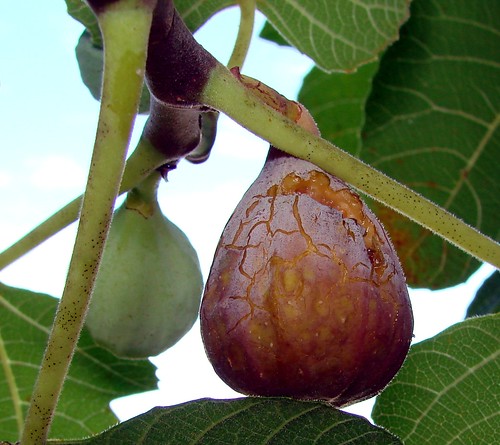
Figs on a tree
The Wikipedia says that there are about 850 species of figs. However, in another article, it also says that the plant that we use is the common fig, Ficus carica. Most of my knowledge of this plant comes from that article.
Figs have been cultivated by humans since about 9,000 B. C., and may have been the earliest cultivated plants. The first evidence for this comes from the Gilgal archaeological site, which is near Jericho.
Figs may be eaten as they are, or made into jam or preserves, or dried. They don't keep well for transport, so are often sold as dried figs. One form of dried figs is fig newtons.
The fruit is sweet, all right. Nearly 48% of a fig's weight is carbohydrate. The good news is that less than 1% is fat. The fruit is almost 10% fiber, by weight. They are a good source of Calcium and flavonols. As some of you probably know, they have a laxative effect.
Perhaps the most interesting aspect of fig life is the way in which fig flowers are fertilized. In the first place, what we think of as a fig fruit hides the flowers, which were, presumably, inside the green fig shown above in the photo. So how are they fertilized? There are wasps, fig wasps, which live inside these fruit/flowers, and move from one to another, pollinating as they goes. In fact, the Wikipedia on fig wasps says that we may be eating wasps when we eat figs. Apparently the wasps are very small. For more on this topic, including photos, see here.
There are videos, from PBS, available here, and here (several segments of an originally longer video). I am not clear as to whether the fig shown in these videos are the figs we grow and eat.
This post is on many of the times figs are mentioned in the Bible.
Thanks for reading!
Figs have been cultivated by humans since about 9,000 B. C., and may have been the earliest cultivated plants. The first evidence for this comes from the Gilgal archaeological site, which is near Jericho.
Figs may be eaten as they are, or made into jam or preserves, or dried. They don't keep well for transport, so are often sold as dried figs. One form of dried figs is fig newtons.
The fruit is sweet, all right. Nearly 48% of a fig's weight is carbohydrate. The good news is that less than 1% is fat. The fruit is almost 10% fiber, by weight. They are a good source of Calcium and flavonols. As some of you probably know, they have a laxative effect.
Perhaps the most interesting aspect of fig life is the way in which fig flowers are fertilized. In the first place, what we think of as a fig fruit hides the flowers, which were, presumably, inside the green fig shown above in the photo. So how are they fertilized? There are wasps, fig wasps, which live inside these fruit/flowers, and move from one to another, pollinating as they goes. In fact, the Wikipedia on fig wasps says that we may be eating wasps when we eat figs. Apparently the wasps are very small. For more on this topic, including photos, see here.
There are videos, from PBS, available here, and here (several segments of an originally longer video). I am not clear as to whether the fig shown in these videos are the figs we grow and eat.
This post is on many of the times figs are mentioned in the Bible.
Thanks for reading!


2 comments:
I happen to be blessed with having a very productive fig tree in my yard. (I live in the deep, deep south - between Houston and Galveston. On the bright side, fig trees are very hurricane-resistant.)
Yep, figs are basically ingrown flowers. I've seen wasps fertilizing among my figs, btw, and I don't consider the wasps small enough to be eaten by unawares. For that matter, for all the times I've made fig jam -- and I often cook 10c worth of figs at a time -- all the time I've been cutting open the figs to jam them, I've never seen a wasp still inside them either. Let that be reassuring to all of you fig-newton fans.
Btw the fresh is, roughly, a zillion times tastier than a fig newton.
I've always wondered whether people in cold climates where you don't have have fig trees really get it about "learn a lesson from the fig tree". But that's neither here nor there.
Take care & God bless
Anne/WF
We used to have a fig tree ourselves, but it died one winter, and we have never replaced it. The photo came from a fairly old plant growing a block or so from our house.
You are right about how figs taste.
Thanks for the comment.
Post a Comment